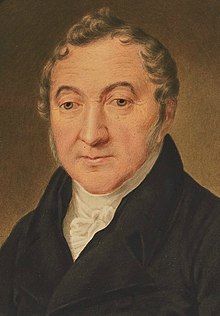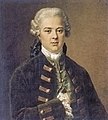Ludwig Erdwin Seyler
Ludwig Erdwin Seyler (often called LE Seyler ) (born May 15, 1758 in Hamburg , † October 26, 1836 in Hamburg) was a Hamburg merchant, banker and politician. He was the son of the famous theater principal Abel Seyler and by marriage belonged to the Berenberg / Gossler banking family .
He worked for the company Joh. Berenberg, Goßler & Co. for 61 years (1775–1836) and succeeded his father-in-law Johann Hinrich Goßler as partner and manager of the company in 1788/90 . The company name was changed to “Joh. Berenberg, Goßler & Co. ”changed to reflect his entry into the company; he "is, so to speak, the 'Co.' in the company name ". Seyler was one of the first German merchants to establish trade relations with the United States and East Asia . He was one of the best-known Hamburg merchants during the Napoleonic Wars , and was politically and socially engaged in a variety of ways, including as a member of the Municipal Council (which replaced the Senate) during the French era and, after the regaining of sovereignty of the city-state, as President of the Commerz Deputation .
Life
Origin and childhood
Ludwig Erdwin Seyler was the son of one of the leading European theater principals of the 18th century, Abel Seyler . His father was born in the Swiss canton of Basel and worked in Hamburg as a merchant and banker before devoting himself to the theater from 1767. His mother Sophie Elisabeth Andreae was the daughter of the wealthy Hanover court pharmacist Leopold Andreae. After the death of his mother in 1764, he and his two siblings grew up with their uncle, the court pharmacist JGR Andreae in Hanover. Andreae was an internationally known scientist and polymath and corresponded a. a. with Benjamin Franklin . According to several reports, Andreae was a loving foster father for his sister's children; he had no children of his own.
The Seyler family was originally a patrician family from Liestal and Basel in Switzerland. Through his father he came from other Basel patrician families such as Burckhardt , Socin (originally an Italian noble family), Merian and Faesch . Among his distant relatives was Cardinal Joseph Fesch , Napoleon's uncle.
His sister Sophie married the Sturm und Drang poet Johann Anton Leisewitz , the author of Julius von Tarent , in 1781 .
Co-owner of the Berenberg company
He joined the Berenberg und Goßler company as an apprentice at the age of 17 in 1775 . On May 20, 1788 he married Anna Henriette (called Henriette) Goßler (1771–1836), the eldest daughter of the company owners Johann Hinrich Goßler and Elisabeth Berenberg . Shortly thereafter, his father-in-law took him on as a partner. After the death of his father-in-law, he took over the management of the company in 1790. His father-in-law himself married his employer's daughter and thus became the owner of the Berenberg company. The company name was changed to “Joh. Berenberg, Goßler & Co. ”changed to reflect his entry into the company; since then it has remained unchanged. The named Joh. Berenberg was his wife's grandfather.
French times, political and social engagement
After the annexation of Hamburg as part of the French Empire in 1811, Seyler was appointed as a supplying judge at the Commercial Court ( Tribunal de Commerce ) in February 1813 .
After the Mortzenhaus had been confiscated by the French authorities and converted into a military hospital, Joh.Berenberg, Gossler & Co.'s headquarters were relocated to Seyler's Wandrahm -Haus. In December 1813, Seyler moved the office to the house of his son-in-law Gerhard von Hoßtrup .
In June 1813, Seyler was one of the prominent Hamburg merchants who were taken hostage by the French in order to blackmail the city into paying a contribution of 48 million francs :
- In order to blackmail at least some of them, the French captured several dozen hamburgers and took them to Harburg, including LE Seyler, Goßler's brother-in-law, the company's senior. Biggest excitement in town, of course! Who was next
He was then appointed as a member of the Municipal Council by Governor General Louis-Nicolas Davout in the summer of 1813 and sworn in on July 9, shortly after he was released as a hostage; the municipal council had replaced both the council (senate) and the citizenry under French rule, and had thirty members. Other members of the municipal council included a. Christian Daniel Benecke and Jacob Oppenheimer. The municipal council existed until May 26, 1814 and was then dissolved by the council. The members of the municipal council were asked by the council to continue to support the council for a short period of time.
He was a member from March 23, 1813 and from May 1817 to July 4, 1818 President of the Commerz Deputation , one of the most important political bodies of the once again sovereign city-state. As a member of the Commerz Deputation, he was ex officio also a member of the Hereditary Citizenship . He was u. a. also member of the Banco Deputation and the Shipping and Port Deputation. From 1820 until his death in 1836 he was senior adjoint of the Commerz deputation (senior adjoints were consulted by the deputies in disputes).
During his life, Seyler was highly regarded in Hamburg; the city historian JG Gallois described him as “a character that is equally respectable as a businessman and as a person” and as “one of the main adornments of our stock exchange”. Percy Ernst Schramm wrote: "He is respected among his fellow citizens, he is a tender father to his people".
In Hamburg he was primarily related to the Berenberg / Goßler and Amsinck families through his wife . He was the uncle of Hamburg's First Mayor Hermann Goßler . The co-founder of Commerzbank Ludwig Erdwin Amsinck (1826–1897) was named after him. Felix Hoppe-Seyler , the founder of biochemistry and molecular biology, was adopted by his nephew and took the name Seyler.
Ludwig Erdwin Seyler and his wife Anna Henriette are remembered on the double collection grave plate of the Gossler family in the Althamburg Memorial Cemetery, Ohlsdorf Cemetery .
His father, the theater principal Abel Seyler
His uncle and foster father, the naturalist JGR Andreae
His wife Anna Henriette Goßler (1771–1836), eldest daughter of Johann Hinrich Gossler and Elisabeth Berenberg
His father Johann Hinrich Gossler took him in 1788 as a partner in the firm Joh. Berenberg and Goßler on
The Mortzenhaus , winter home of the Goßler family and headquarters of the Berenberg, Goßler & Co. from 1788
Individual evidence
- ↑ Wolfgang Seidel (2019): "The oldest bank in Germany: Berenberg". In: The oldest family businesses in Germany , pp. 34–41, FinanzBuch Verlag
- ^ New German Biography , Vol. Behaim-Bürkel, p. 68, Bavarian Academy of Sciences, 1953
- ↑ Le Moniteur westphalien: gazette officielle , 1813, p. 228
- ↑ a b c Percy Ernst Schramm : “Merchants during occupation, war and siege (1806–1815); Hamburg trading in the French era, illustrated using company and family papers ”. In tradition: Journal for Company History and Entrepreneur Biography, Volume 4, Issue 1 (February 1959), pp. 1–22. "II. Part". In year 4, issue 2 (April 1959), pp. 88-114
- ↑ Wolf-Rüdiger Osburg, The administration of Hamburg in the French period 1811–1814 , p. 86, P. Lang, 1988
- ^ Efforts and effectiveness of the Commerz deputation
- ^ Gallois, JG (1856). History of the city of Hamburg: special history of the city since 1814 . 3. p. 497.
literature
- Percy Ernst Schramm , Nine Generations: Three Hundred Years of German Cultural History in the Light of the Fate of a Hamburg Bourgeois Family (1648–1948) , Vol. I, Göttingen, 1963
| personal data | |
|---|---|
| SURNAME | Seyler, Ludwig Erdwin |
| ALTERNATIVE NAMES | Seyler, Erwin; Seyler, Ludewig |
| BRIEF DESCRIPTION | German merchant and banker |
| DATE OF BIRTH | May 15, 1758 |
| PLACE OF BIRTH | Hamburg |
| DATE OF DEATH | October 26, 1836 |
| Place of death | Hamburg |







